
Rolf Weinstock, a Jewish survivor from Emmendingen near Freiburg, describes the people dying in the liberated camp:
“All the necessary medicine and urgently needed bandages were brought in right away to reduce the death rate as quickly as possible. Yet, despite all the aid measures, this could not be achieved as quickly as desired. There were far too many prisoners in a desperate state. There were prisoners in our district between the ages of 30 and 50 who only weighed around 25 kilograms. There was simply no hope of saving their lives. It was only a small consolation that these poor people had the joy of experiencing the day of liberation.”
Rolf Weinstock, Das wahre Gesicht Hitler-Deutschlands, Singen 1948.




the cemetery at the Bismarck Tower, around 27 April 1945. The graves were marked with signs, crosses and Stars of David. Photo: Alfred Stüber ©Jehovas Zeugen, Archiv Zentraleuropa


Despite the emergency medical measures being taken, help came too late for many of the weak and ill. The number of deaths declined slowly. By early July 1945, several hundred liberated prisoners had died in the liberated camp and nearby hospitals of exhaustion, lung disease, typhus and other illnesses. The dead were buried in mass graves shortly after the camp was liberated. In late April, a cemetery was created at the nearby Bismarck Tower. The dead were buried there with dignity and respect for their religion. The cemetery is now part of the memorial complex.

